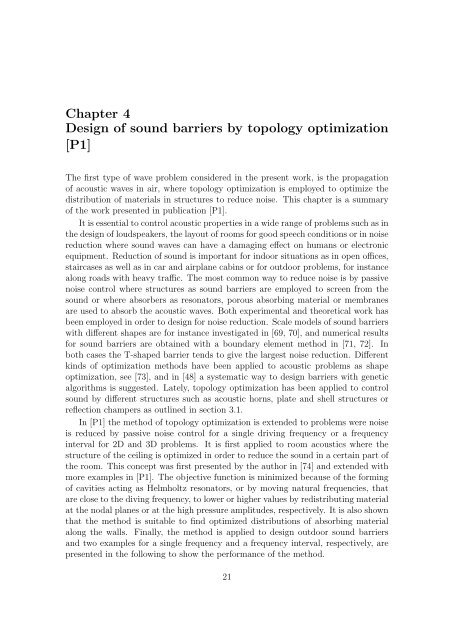Maria Bayard Dühring - Solid Mechanics
Maria Bayard Dühring - Solid Mechanics
Maria Bayard Dühring - Solid Mechanics
You also want an ePaper? Increase the reach of your titles
YUMPU automatically turns print PDFs into web optimized ePapers that Google loves.
Chapter 4<br />
Design of sound barriers by topology optimization<br />
[P1]<br />
The first type of wave problem considered in the present work, is the propagation<br />
of acoustic waves in air, where topology optimization is employed to optimize the<br />
distribution of materials in structures to reduce noise. This chapter is a summary<br />
of the work presented in publication [P1].<br />
It is essential to control acoustic properties in a wide range of problems such as in<br />
the design of loudspeakers, the layout of rooms for good speech conditions or in noise<br />
reduction where sound waves can have a damaging effect on humans or electronic<br />
equipment. Reduction of sound is important for indoor situations as in open offices,<br />
staircases as well as in car and airplane cabins or for outdoor problems, for instance<br />
along roads with heavy traffic. The most common way to reduce noise is by passive<br />
noise control where structures as sound barriers are employed to screen from the<br />
sound or where absorbers as resonators, porous absorbing material or membranes<br />
are used to absorb the acoustic waves. Both experimental and theoretical work has<br />
been employed in order to design for noise reduction. Scale models of sound barriers<br />
with different shapes are for instance investigated in [69, 70], and numerical results<br />
for sound barriers are obtained with a boundary element method in [71, 72]. In<br />
both cases the T-shaped barrier tends to give the largest noise reduction. Different<br />
kinds of optimization methods have been applied to acoustic problems as shape<br />
optimization, see [73], and in [48] a systematic way to design barriers with genetic<br />
algorithms is suggested. Lately, topology optimization has been applied to control<br />
sound by different structures such as acoustic horns, plate and shell structures or<br />
reflection champers as outlined in section 3.1.<br />
In [P1] the method of topology optimization is extended to problems were noise<br />
is reduced by passive noise control for a single driving frequency or a frequency<br />
interval for 2D and 3D problems. It is first applied to room acoustics where the<br />
structure of the ceiling is optimized in order to reduce the sound in a certain part of<br />
the room. This concept was first presented by the author in [74] and extended with<br />
more examples in [P1]. The objective function is minimized because of the forming<br />
of cavities acting as Helmholtz resonators, or by moving natural frequencies, that<br />
are close to the diving frequency, to lower or higher values by redistributing material<br />
at the nodal planes or at the high pressure amplitudes, respectively. It is also shown<br />
that the method is suitable to find optimized distributions of absorbing material<br />
along the walls. Finally, the method is applied to design outdoor sound barriers<br />
and two examples for a single frequency and a frequency interval, respectively, are<br />
presented in the following to show the performance of the method.<br />
21
















